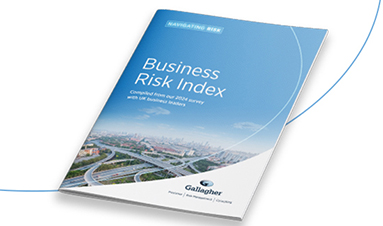An analysis of the most pressing concerns based on insights from 1,000 UK business leaders.
Author: Barry Marler

However, following the unfortunate events in Ukraine the outlook is now uncertain and developments in the coming weeks and months, are likely to play a significant part in the future direction of the market.
I am now in my fourth decade of working in the aviation insurance market and when discussing GA trends and drivers, I’ve rarely had to make reference to what is going on in the Hull War market. Yes, we have witnessed some serious rating corrections in the Hull War market, on occasions where major losses have happened i.e. 9/11, the Colombo airport attack, MH17, the Tripoli airport attack, but usually these are relatively short lived and infrequent. Traditionally, a GA buyers Hull War rates will be minimal and in essence, this portion of the client’s premium spend will be so negligible that a double or even triple digit increase would to some degree be lost in the cost of what is going on in the main All Risks placement. Recent years however have seen a more sustained hardening and increased loss activity, and now with the Russia/Ukraine situation having brought new uncertainty and a host of sanctions complications, this class of business may well become a more prominent aspect of future GA renewal discussions.
Rates and Premium
As my colleague highlighted in our last edition of Plane Talking, conditions have been improving for GA buyers and as 2021 concluded an ‘as before’ rating offering from the leader was generally an accepted starting point for negotiations. This trend has continued into 2022, and with increased capacity available, this has led to a reduction in the vertical differentials, and has actually yielded rate reductions for those client renewals with subscription markets on their risk. In the opening quarter of 2022, we have seen an uptick in underwriter scrutiny around risk specifics, but positively, underwriters have tended to use this client information to find a way to make it fit their pricing models in order to either participate or offer an increased share, rather than to find a reason to not write the risk.
One or two risks are now seeing reductions although this position is far from the ‘norm’ at present. As with all previous insurance cycles, I think we can expect to see more markets offering competitive quotes to take over leads rather than sitting back waiting for an offer, which may not come, due to previous appetite discussions with the client’s broker. Holding out for higher terms may have been the best strategy for an underwriter in 2020/2021, but going forward this approach will leave markets with lower premium income, which in itself could lead to them trying to buy their way onto risks in the last quarter of 2022.
Notwithstanding the above, we must touch on the unfortunate situation in Ukraine and the subsequent sanctions against Russia, which have the potential to become a significant market loss event. This situation has brought an element of uncertainty to the outlook and rating trajectory, but it is too early to discuss outcomes and any claims may involve years of litigation. Although we expect conditions to remain stable with insurers taking a measured response, that could change without notice if the market sees significant claims coming in on the airline portfolio.
Capacity & Losses
Always intrinsically linked, continued good loss experience in the market will of course lead to existing players wanting more of the pie and new players eyeing the crumbs and hoping to upgrade to a full slice. What we have yet to see is where the market will go if reductions become the norm. It could well be that the flexibility of the class underwriter is curtailed by the omnipotent actuaries, who have ultimate say on where the business needs to head, but if the call comes out to achieve premium income targets rather than maintain a no reduction policy, the downward trend in rates could take on the same snowball effect we have seen in previous cycles. The question then will be how long will it take the market to react, because more of my years have been spent sliding down the cycle than trying to climb back up it.
Future outlook
- We expect conditions to remain stable in the short-term with insurers taking a measured response
- The Russia/Ukraine situation has brought uncertainty around the longer-term trending
- Substantial claims have the potential to impact future market conditions across the entire aviation class, and so the GA sector could experience a knock-on effect in terms of pricing
- Individual loss records and policy specifics of each operator will remain a major driving factor in pricing
- Variation in pricing levels between risks in different geographies and operational sub-sets will also remain.




